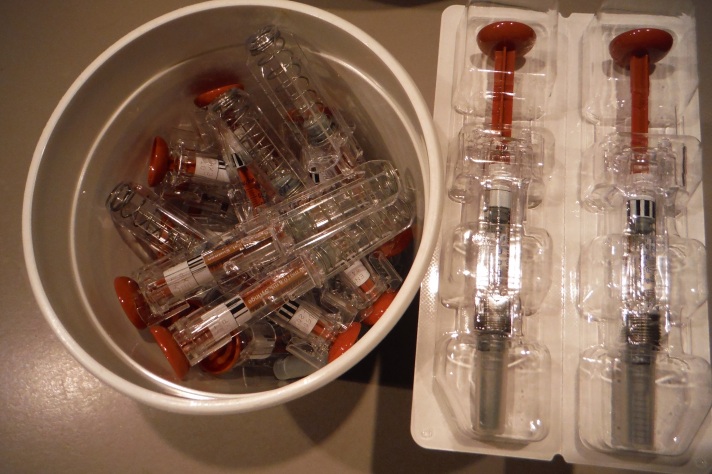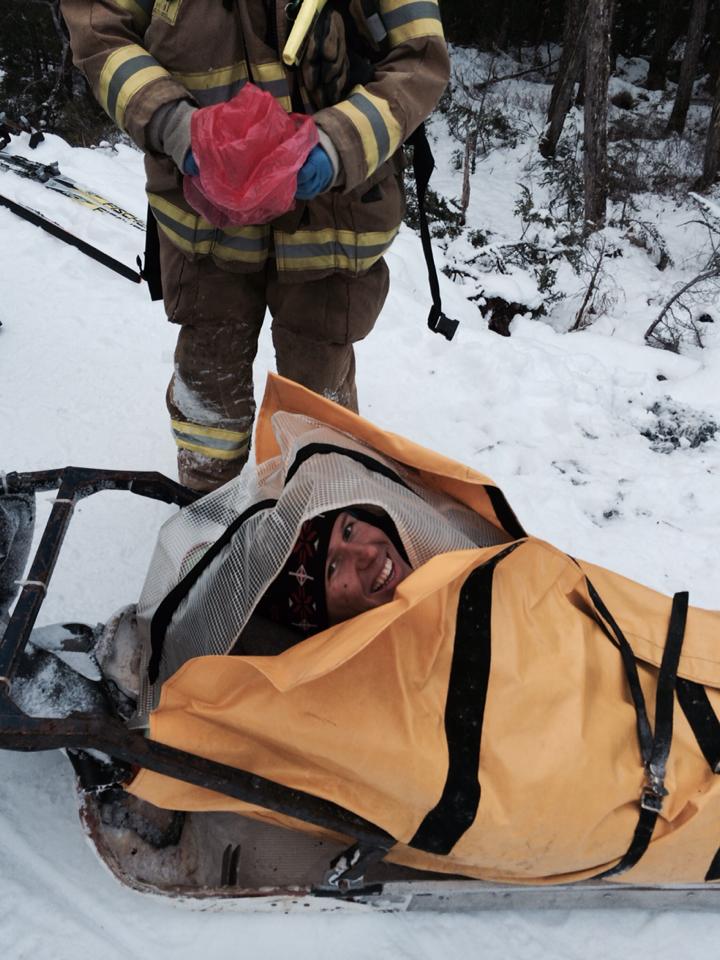They say a picture is worth a thousand words. Unfortunately, for many unexpected incidents, or accidents, recorded media is rarely present. Two days before, my teammate Reese Hanneman was skiing loops of the Girdwood 5k with his GoPro, but on the day in question, there were no witnesses other than the two of us involved. Lex Treinen led the downhill, while the other APU men – Reese, Eric Packer, David Norris, and Tyler Kornfield – were just out of sight behind Erik Bjornsen and me.
No one was there to preserve and record the image of Erik Bjornsen carving into the slightly off-camber corner and suddenly losing his edge and contact with snow. The dark snow-free evergreens and bright snow framing Bjornsen’s silhouette, momentarily airborne, lingers only in my memory. In the next moment, he was uncontrollably sliding across the trail as I looked down from above. Despite my best effort to step around, my skis threaded between his equipment. For a brief instant, I thought the tangle would unravel with minimal damage, but in the next second I was sliding too, simultaneously wondering what kind of bruise would arise from the pain spiking through my upper thigh.
As we recovered our wits, the first step was checking in. Erik managed a quick query as to whether I was alright. From the fact that I am writing about this, you can probably guess that the answer was no, but my answer that day was a drawn-out “yes…. actually no” as I finally took a look at my leg.
Unlike Marcus Hellner’s hole ski imprint from Sochi (http://imgur.com/LejCnte), where he struck the ski tip of a competitor, I collided with a broken ski. The bruising that I was expecting to see was instead occupied by a large laceration with several pieces of ski sticking out. My training tights were obliterated and the gash looked as if my leg had burst through my skin from excess internal pressure. As more people congregated and others departed for help, the universal action was to donate another blue jacket to the massive pile on the side of the trail with me somewhere underneath. Sitting on the cold snow in sweaty workout gear from our earlier sprint simulations, I appreciated each new layer. While my teammates and coaches dealt with the issue of getting help, I just stared at my leg. Although the laceration was barely bleeding, my rudimentary wilderness first aide knowledge indicated I should keep pressure on the wound; however, there were two large pieces of ski protruding from my leg preventing compression. To remove or not to remove became the sole quandary. After a few minutes of inactivity, I decided removing them was the best alternative, so I pulled a ragged two inch long strip of carbon and a larger chunk of the edge of Bjornsen’s ski from my leg. Then, all I could do was wait.
The rest of the day was a drawn out process involving various medical professionals. I was loaded into a sled and pulled off the trails by snowmachine, briefly sat in an ambulance, visited the Girdwood clinic for initial cleaning, and then was driven to the hospital in Anchorage. There had been a road closure on the Seward Highway between Girdwood and Anchorage, due to a fatal six car accident that occurred simultaneously to my accident. The road was reopened just as I was ready to make the trip to Anchorage. Alpine Air, the standard for Eagle Glacier flights and key organizers for Girdwood Nordic Ski Club, had offered me helicopter transport, but with the road open I was able to get to the hospital quickly enough especially as I was in a stable condition. Once in Anchorage, I ended up spending about eight hours reading old budget travel and fashion magazines in the emergency room as I waited for the orthopedic surgeon to become available. Around 1am the surgeon was ready to put me under general anesthesia in order to remove the remaining pieces of ski and stitch up the wound. Finally, about 15 hours after the crash with one leg numb from nerve blockers, I was discharged and headed home.

Unfortunately, that incident and subsequent recovery expected from the leg wound does not end the story. One of my UVM professors told me that the difference between alpine skiers and nordies is that the alpiners know their surgeon by name. A month ago, I was solidly in the “nordie” category and didn’t have any experience with surgeons. But in this past month, I not only got to know my surgeon, but my anesthesiologist, several internist doctors, the ER director, several ER doctors, and quite a few nurses. Not all of these new acquaintances were from stitching my leg after the crash.
Five days into the recovery period, I began noticing an odd pain in my back. Due to the surficial location, I attributed the pain to strains from sitting in a weird position for most of the day. As the night progressed, the discomfort stole my sleep. In the morning, I could tolerate sitting or standing, but I experienced extreme discomfort otherwise. Around noon, the pain reached a point that I took some of the oxycodone that I had for my legs. Soon afterwards, shortness of breath set in along with building pain. Another trip to the ER was in order. This became even more evident as I struggled to breath and could not fully stand up during the 30 ft walk to the car. Once at the hospital, a CT scan quickly indicated to the doctors that what I initially thought was a strained muscle was actually a pulmonary embolism. Due to surgery, trauma, and stasis a larger blood clot had formed in my leg and migrated into my right lung. A slightly smaller clot had also formed in my left lung. This occurred despite the fact that I had been wearing compression sleeves on my legs since surgery and my risk of clotting was considered to be low. Somewhere in the discussion with the doctors they mentioned the need to “move me upstairs.” Only then did it become really clear that I would be in the hospital for a while and that racing at West Yellowstone for the first Supertour this year was probably out of the picture.
Three days after my second visit to the ER, I was released from the hospital, after eight days I had my stitches removed, and after ten days, I no longer needed to inject nasty shots of high-strength blood thinner in my stomach and could transition to only pills. The possibility of the clots dislodging and causing further damage posed the greatest risk during the early recovery. With inactivity a prerequisite for recovery, my training became walks around the block and inhalation exercises. Over the next few months while on blood thinners, I can gradually ease back into activity, training, and eventually racing.
While I was the victim of two freak events, the possibilities for more extensive injury loomed very close by. Although my surgeon was able to see both the femoral artery and the vascular bundle as he dug around three inches into my leg, both were undamaged in the crash. Additionally, the broken ski missed my muscles and nerves and only entered the fascial tissue. In the case of the clot, I was able to avoid significant damage to my lungs by making the trip to the ER promptly, and receiving a quick and accurate diagnosis. Blood clots, which often originate due to deep woods like my leg, can travel to the heart, lungs or brain. In extreme cases, heart failure, suffocation, or strokes are all possible. I was fortunate to have been dosed with blood thinners quickly, before the clots in my lungs became worse or dislodged. Luckily, there was no permanent damage, and while I have healing scar tissue in my legs and blood clots that will gradually dissolve in my lungs, I am optimistic that I’ll be able to make a full recovery and return to racing mid-winter. Then, I just have to remember how fast I was feeling before the crash.

5 thoughts on “60 to 0 MPH”